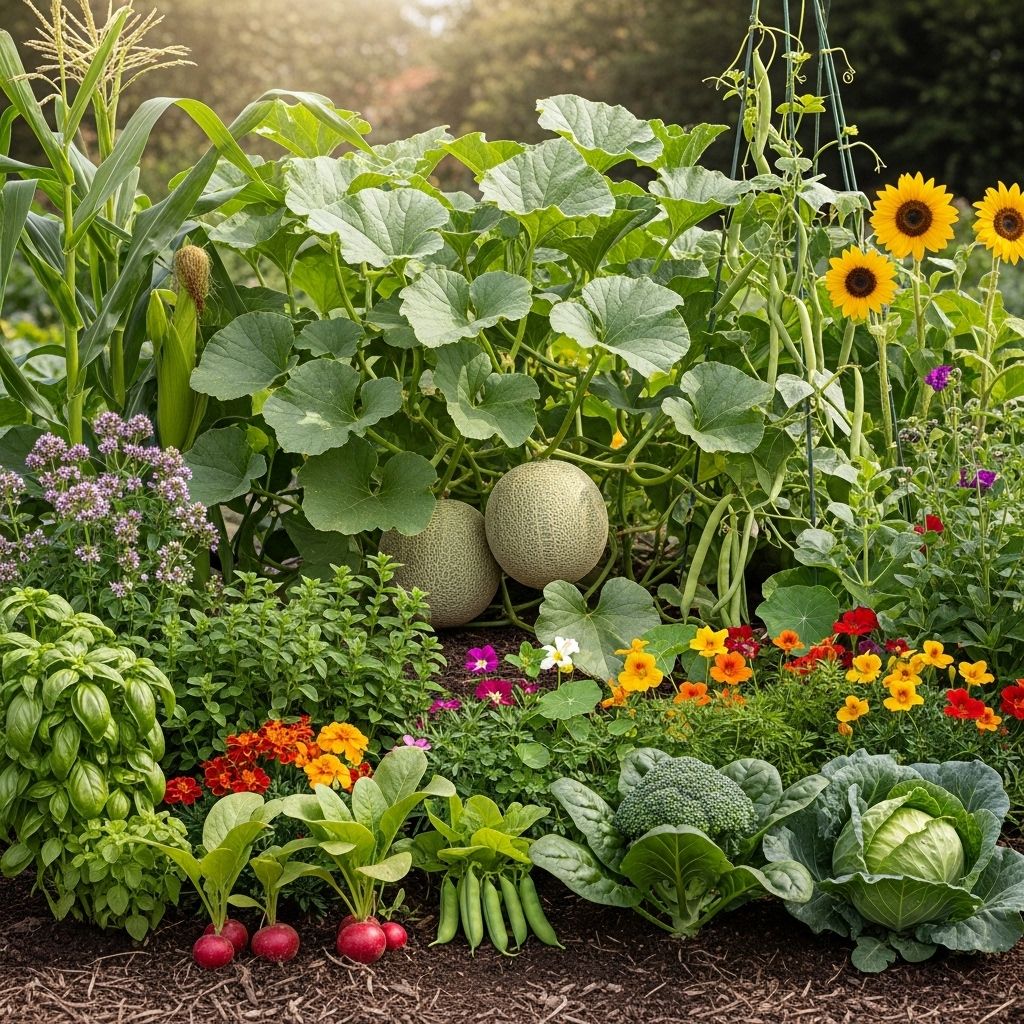Cantaloupe Companion Planting: 17 Best Garden Companion Plants
Boost cantaloupe harvests and thwart pests by pairing melons with the right companions.

Image: HearthJunction Design Team
17 Best Cantaloupe Companion Plants for a Thriving Garden
Cantaloupe, with its sprawling vines and sweet fruits, is a summer garden favorite. Many gardeners worry that these vigorous melons need to be isolated, but companion planting proves that you can integrate cantaloupe into a bustling, productive plot. By sharing space with the right plant partners, cantaloupes benefit from enhanced growth, increased pollination, natural pest deterrence, and improved soil conditions. This comprehensive guide explores the top 17 cantaloupe companion plants and gives practical tips for designing a harmonious melon patch.
Why Practice Companion Planting with Cantaloupe?
Companion planting is the art and science of positioning crops that support one another in close proximity. For cantaloupe, this approach offers several advantages:
- Enhanced pollination: Flowering companions attract bees and pollinators, crucial for cantaloupe fruit set.
- Pest control: Certain plants repel or distract harmful insects, reducing the need for chemical interventions.
- Better yields: Strategic companions can enrich soil nutrients and create optimal growing conditions.
- Disease reduction: Some flowers and herbs can help break pest and disease cycles in the garden.
Forget the myth that melons must have the garden to themselves. With thoughtful planning, you can build a diverse and robust ecosystem around your cantaloupe!
Cantaloupe as a Companion Plant
Cantaloupe’s large, leafy vines create shade and suppress weeds. However, their expansive growth can also crowd out nearby plants if not managed. When choosing companions, focus on crops that:
- Don’t mind a bit of shade or root competition
- Thriv e in rich, consistent moisture
- Are not overly tall or aggressive
With these criteria in mind, let’s dive into the best partners for cantaloupe in your garden.
Top 17 Cantaloupe Companion Plants
Basil
Basil is prized not just for its flavor, but for its role as a pest deterrent. The aromatic oils in basil leaves repel flies, aphids, and beetles that might otherwise munch on melon vines. Interplant basil at the cantaloupe’s edge for a fragrant, productive border that also boosts pollinator visits.
Beans
Beans, especially bush varieties, are excellent melon companions. They fix nitrogen in the soil, naturally increasing fertility for heavy feeders like cantaloupe. Sow beans between melon hills or as a perimeter planting. Pole beans on trellises nearby can also work, as long as they don’t shade out the melons.
Borage
Borage is a superstar pollinator magnet, drawing bees with its star-shaped blue flowers. Borage also repels tomato worms and hornworms while reportedly improving the flavor and growth of cantaloupe. Its deep taproots may help break up soil and bring up minerals from lower layers.
Carrots
Carrots fill in the ground beneath vining melons, making efficient use of space. Their humble, feathery tops won’t compete for sunlight, while the roots remain undisturbed beneath the surface. Carrots also improve soil aeration as they grow.
Cilantro
Cilantro’s strong scent confuses and drives away many melon pests, including aphids and spider mites. Plus, its lacy flowers are highly attractive to tachinid flies and parasitic wasps, both beneficial insect allies.
Corn
Sweet corn’s upright growth pairs nicely with sprawling melons, maximizing vertical and horizontal space. However, avoid planting cantaloupe directly beneath corn, as the dense canopy can cast too much shade. Instead, border melon beds with a row of corn for wind protection and some shared nutrient benefit.
Dill
Dill serves double duty in the garden: attracting beneficial hoverflies and lacewings while deterring squash bugs and aphids. Allow a few dill plants to flower near your melon patch for best results, but avoid letting them self-seed excessively.
Garlic
Garlic’s pungent aroma naturally repels a range of pests, notably aphids and spider mites. Plant garlic as a border around your cantaloupe bed, or intersperse cloves between melon hills in the fall for a head start come spring.
Lettuce
Lettuce is a fast-maturing, shallow-rooted crop that does well in the dappled shade beneath cantaloupe vines. This pairing protects lettuce from heat stress and makes the most of garden real estate.
Marigold
Marigold is famous for deterring nematodes, aphids, and beetles thanks to its aromatic roots and flowers. Marigolds also attract beneficial insects such as ladybugs and hoverflies, making them a must-have companion in any melon patch.
Mint
Mint’s volatile oils repel many insect pests, including aphids and ants. However, mint can be aggressively invasive, so plant it in containers and strategically place pots around your melon area, rather than directly in the bed.
Nasturtium
Nasturtiums act as a colorful “trap crop,” luring aphids away from your cantaloupe. Their bright flowers draw pollinators as well, doubling their benefit. Allow nasturtium vines to meander around the outside of melon beds.
Onions
Onions, like other alliums, exude sulfur compounds that repel numerous garden pests. Their slender growth habit fits easily between melon hills without crowding, and harvesting onions in midsummer frees up space as melons begin to spread.
Oregano
Low-growing oregano acts as a living mulch, covering bare soil and stifling weeds. Its herbal scent helps mask the presence of melons from pest insects while inviting bees to its tiny flowers.
Radishes
Radishes are quick to mature and can be sown among cantaloupe vines to break up soil and provide an early crop. Their roots are said to repel cucumber beetles, a common melon pest.
Sunflowers
Sunflowers bring in droves of pollinators and create a cheerful, protective border for cantaloupe. Their deep roots also draw up nutrients, which can benefit nearby heavy feeders. Be mindful of their size—plant sunflowers on the north side of your melon patch so they don’t cast too much shade.
Yarrow
Yarrow’s clusters of flowers lure in beneficial insects like ladybugs, lacewings, and parasitic wasps, all crucial for natural pest control. Its feathery foliage also provides an attractive groundcover among melon vines.
What Not to Plant Near Cantaloupe
While many plants make excellent melon companions, a few should be avoided due to their tendency to share pests or compete for resources:
- Cucumbers: Cantaloupe and cucumbers share many pests (like cucumber beetles) and diseases; separate these crops in your rotation.
- Potatoes: Potatoes compete for nutrients and water, making them poor neighbors for melons.
- Other vining melons: Watermelon, pumpkin, and squash can compete for space, light, and nutrients, leading to stunted growth or increased pest problems.
Tips for Successful Cantaloupe Companion Planting
- Space plants properly so cantaloupe vines have room to sprawl; overcrowding can reduce airflow and promote disease.
- Use trellises for vertical companions like beans or sunflowers, positioned so they don’t shade melons.
- Water consistently; many companion plants have similar needs to cantaloupe, but keep an eye out for water hogs nearby.
- Rotate crops each year to minimize soil-borne diseases and pest buildup.
- Mulch generously around melons and companions to retain moisture and suppress weeds.
Quick Reference Table: Cantaloupe Companions
| Companion Plant | Primary Benefit | Notes |
|---|---|---|
| Basil | Pest deterrent, attracts pollinators | Plant near melon patch edges |
| Beans | Fix nitrogen in soil | Bush types are best |
| Borage | Pollinator magnet, pest repellent | Flowers improve melon flavor |
| Carrots | Uses under-vine space | Improves soil aeration |
| Cilantro | Repels aphids, attracts beneficials | Let a few plants flower |
| Corn | Wind protection, nutrient sharing | Avoid direct shade over melons |
| Dill | Attracts lacewings, repels pests | Allow to flower for full benefit |
| Garlic | Pest deterrent | Plant as border or between hills |
| Lettuce | Utilizes shade, fast crop | Plant beneath vines |
| Marigold | Repels nematodes, attracts pollinators | Border or interplant |
| Mint | Pest deterrent | Keep contained in pots |
| Nasturtium | Trap crop, attracts pollinators | Let trail along borders |
| Onion | Pest deterrent | Plant between melon hills |
| Oregano | Living mulch, pest deterrent | Low-growing groundcover |
| Radish | Pest deterrent, soil aeration | Quick crop under vines |
| Sunflower | Pollinator attractant, nutrient cycling | Plant on north side |
| Yarrow | Attracts beneficial insects | Use as border or interplant |
Frequently Asked Questions (FAQs) About Cantaloupe Companion Planting
What are the best companion plants for cantaloupe?
Basil, bush beans, borage, carrots, cilantro, corn, dill, garlic, lettuce, marigold, mint, nasturtium, onion, oregano, radish, sunflower, and yarrow all provide various benefits, from pest control to improved pollination and richer soil.
Can I plant cucumbers near cantaloupes?
It’s best to avoid planting cucumbers near cantaloupes since both attract similar pests, such as cucumber beetles, and are susceptible to many of the same diseases. This proximity can increase the risk of infestations spreading between the two crops.
How does companion planting help control pests for cantaloupe?
Many cantaloupe companions, like marigold, garlic, nasturtium, and radish, emit odors or create habitats for beneficial insects that deter or prey on common melon pests. This natural pest control reduces the reliance on chemical pesticides and helps maintain garden balance.
Should I be concerned about cantaloupe vines crowding other plants?
Cantaloupe vines need space to sprawl. When planning your bed, give melons ample room—usually at least 24-36 inches between hills or plants. Use low-growing, fast-maturing, or vertical companions to minimize crowding and competition for light.
How should I arrange companion plants around cantaloupe?
Plant low and fast-growing crops, like lettuce and radish, between melon hills. Use upright companions such as corn or sunflower on the north or east side to avoid shading. Interplant herbs and flowers in clusters around the patch edge to serve as pollinator or beneficial insect hubs.
Final Thoughts
Embracing companion planting with cantaloupe can transform your melon patch into a lively, productive ecosystem. By incorporating a variety of supportive plants—edible herbs, pest-repelling flowers, soil-enhancing legumes—you’ll enjoy a healthier harvest, fewer pest problems, and a more beautiful garden. Remember, the best partnerships are tailored to your unique conditions, so observe, experiment, and adapt as your garden grows. Happy planting!
References
Read full bio of Shinta












